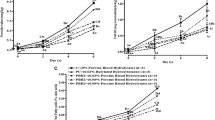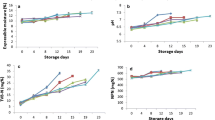Abstract
Indian white prawns headless and with shell on were vacuum packed in ethylene-vinyl alcohol pouches and subjected to high pressure treatment of 100, 270, 435 and 600 MPa at 25 °C for 5 min. Subsequently the treated samples were stored in ice (2 ± 1 °C) along with control. The samples were periodically analysed to study the changes in total viable count, total Enterobacteriaceae count, K value and overall acceptability. Total viable count, total Enterobacteriaceae count and K value reduced proportionately with increasing high pressure treatment. However, K value and total viable count showed an increasing trend during chill storage whereas total Enterobacteriaceae decreased. No significant difference in K value was observed between control and 100 MPa, while higher pressure treated samples showed a significant difference (P < 0.05). However, among the treatments 270 MPa was found to have better sensory acceptability.




Similar content being viewed by others
References
Carballo, J., Fernández, P., Carrascosa, A. V., Solas, M. T., & Jiménez Colmenero, F. (1997). Characteristics of low and high-fat beef patties effects of high hydrostatic pressure. Journal of Food Protection, 60, 48–53.
Chong, G., & Cossius, A. R. (1983). A differential polarized flurometric study of the effects of high hydrostatic pressure upon the fluidity of cellular membranes. Biochemistry, 22, 409.
Cruz-Romero, M., Kerry, J. P., & Kelly, A. L. (2008). Changes in the microbiological and physicochemical quality of high-pressure-treated oysters (Crassostrea gigas) during chilled storage. Food Control, 19, 1139–1147.
Dalgaard, P. (2000). Fresh and lightly preserved seafood. In C. M. D. Man & A. A. Jones (Eds.), Shelf life evaluation of foods (pp. 110–139). Maryland: Aspen Publishers.
Ehira (1976). Biochemical study on the freshness of fish. Bulletin of Tohoku Regional Fisheries Research Laboratory, 88, 1–5.
Errol, V. R., (2007). High hydrostatic pressure processing of seafood. Avure Technologies.
Farkas, D. F., & Hoover, D. G. (2000). High pressure processing. Kinetics of microbial inactivation for alternative food processing technologies. Journal of Food Science, 65, 47–64.
Gram, L., & Huss, H. H. (2000). Flesh and processed fish and shellfish. In B. M. Lund, T. C. Baird-Parker, & G. W. Gould (Eds.), The microbiological safety and quality of food (Vol. 1, pp. 472–506). Maryland: Aspen Publishers.
Hoover, D. G., Metrick, C., Papineau, A. M., Farkas, D. F., & Knorr, D. (1989). Biological effects of high hydrostatic pressure in food microorganism. Food Technology, 43–99.
ICMSF. (1978). Microorganisms in foods. The International Commission on Microbiological Specifications for Foods, vol. 2. Toronto, Canada: University of Toronto Press.
Ignacio-Ortea, Alicia-Rodríguez, Gipsy-Tabilo-Munizaga, Mario-Peŕez-Won, Santiago, P., & Aubourg (2010). Effect of hydrostatic high-pressure treatment on proteins, lipids and nucleotides in chilled farmed salmon (Oncorhynchus kisutch) muscle. European Food Research and Technology, 230, 925–934.
Jacob, S. S., Iyer, K. M., Nair, M. R., & Pillai, V. K. (1962). Quality studies on round, headless and peeled and deveined prawns held in ice storage. Indian Journal of Fisheries, 9(2), 97.
Jose, L. H., Pilar-Montero, Javier-Borderías, & Maria-Solas. (2001). High-pressure/temperature treatment effect on the characteristics of octopus (Octopus vulgaris) arm muscle. European Food Research and Technology, 213, 22–29.
Juan, S. L., David, H. K., Julia, S. M., Gary, P. R., Marshall, G. L., Gwen, M. A., Scot, R. S., Marina, L. F., Peter, F. T., George, J. F., & Christine, L. M. (2011). Randomized, double-blinded clinical trial for human norovirus inactivation in oysters by high hydrostatic pressure processing. Applied and Environmental Microbiology, 77(15), 5476–5482.
Kamalakanth, C. K., Ginson, J., Bindu, J., Venateswarlu, R., Das, S., Chauhan, O. P., & Gopal, T. K. S. (2011). Effect of high pressure on K-value, microbial and sensory characteristics of yellowfin tuna (Thunnus albacares) in EVOH films during chill storage. Innovative Food Science and Technology, 12, 451–455.
Kimura, K., Ida, M., Yosida, Y., Ohki, K., Fukumoto, T., & Sakui, N. (1994). Comparison of keeping quality between pressure-processed jam and heat-processed jam: changes in flavour components, hue and nutrients during storage. Bioscience Biotechnology and Biochemistry, 58, 1386–1391.
Ko, W. C., & Hsu, K. C. (2001). Changes in K-value and microorganisms of tilapia fillet during storage at high-pressure, normal temperature. Journal of Food Protection, 64, 94–98.
Koutsoumanis, K., & Nychas, G. J. E. (1999). Chemical and sensory changes associated with microbial flora of Mediterranean boque (Boops boops) stored aerobically at 0, 3, 7, and 10 °C. Applied and Environmental Microbiology, 65, 698–706.
Lakshmanan, P. T., Antony, P. D., & Gopakumar, K. (1996). Nucleotide degradation and quality changes in mullet and pearl spot in ice and at ambient temperatures. Food Control, 7, 277–283.
Leadley, C. (2009). High pressure processing of fish and shellfish. Seafish, Fact sheet 09.
Lopez-Caballero, M. E., Perez-Mateos, M., Bonderıas, A. J., & Montero, P. (2000). Extension of shelf life of prawns (Penaeus japonicus) by vacuum packaging and high-pressure treatment. Journal of Food Protection, 63, 1381–1388.
Meilgaard, M., Civille, G. V., & Carr, B. T. (1999). Sensory evaluation technique (3rd ed., p. 387). Boca Raton: CRC.
Montero, P., Lopez-Caballero, M. E., & Perez-Mateos, M. (2001). The effect of inhibitors and high pressure treatment to prevent melanosis and microbial growth on chilled prawns (Penaeus japonicus). Journal of Food Science, 66(8), 1201–1206.
Nair, R. B., & Lahiry, N. L. (1968). Factors affecting the quality of fresh fish and its retention by chilling. Journal of Food Science and Technology, 5(3), 107.
Pillai, V. K., Shastri, P. V. K., & Nayar, M. R. (1961). Observation on some aspects of spoilage in fresh and frozen prawns. Indian Journal of Fisheries Science, 8(2), 430.
Ryder, J. M. (1985). Determination of adenine triphosphate and its breakdown products in fish muscle by high performance liquid chromatography. Journal of Agricultural and Food Chemistry, 3, 673.
Saito, T., Arai, K., & Matsuyoshi, M. (1959). A new method of estimating the freshness of fish. Bulletin of the Japanese Society for the Science of Fish, 24, 749.
Shewan, J. M., Mackintoch, R. G., Tucher, C. G., & Erhenberg, A. S. C. (1953). The development of a numerical scoring system for the sensory assessment of the spoilage of wet fish stored in ice. Journal of the Science of Food and Agriculture, 6, 183–198.
Shoji, T., & Saeki, H. (1989). Use of high pressure on food. In R. Hayashi (Ed.), High pressure science for foods (pp. 75–87). Kyoto: San-ei Publications.
Smelt, J. P. P. M. (1998). Recent advances in the microbiology of high pressure processing. Trends in Food Science and Technology, 9, 152–158.
Acknowledgements
The authors acknowledge the financial assistance provided by the National Agricultural Innovation Project (NAIP) (Grant No: NAIP/C4/C-30027/2008-09), Indian Council of Agricultural Research, for carrying out this work. We are also indebted to the director of the Defence Food Research Laboratory, Mysore, for providing the HP treatment facilities at their institute. The help rendered by Mr. Joshy C.G., Scientist, Central Institute of Fisheries Technology, for statistical analysis is gratefully acknowledged.
Author information
Authors and Affiliations
Corresponding author
Appendix 1
Appendix 1
Sensory Evaluation
Assessor: _______________________ Date: __________
Cooked prawn:
Attributes | Sample I | Sample II | Sample III | Sample IV | Sample V |
Appearance | |||||
Colour | |||||
Odour | |||||
Flavour | |||||
Taste | |||||
Texture | |||||
i. Firmness | |||||
ii. Succulence | |||||
iii. chewiness | |||||
iv. Toughness | |||||
Overall acceptability |
Please score the sample characteristics according to the following scale
Quality grade description | Score |
Like extremely | 09 |
Like very much | 08 |
Like moderately | 07 |
Like slightly | 06 |
Neither likes nor dislikes | 05 |
Dislike slightly | 04 |
Dislike moderately | 03 |
Dislike very much | 02 |
Dislike extremely | 01 |
Comments:
Rights and permissions
About this article
Cite this article
Ginson, J., Kamalakanth, C.K., Bindu, J. et al. Changes in K Value, Microbiological and Sensory Acceptability of High Pressure Processed Indian White Prawn (Fenneropenaeus indicus). Food Bioprocess Technol 6, 1175–1180 (2013). https://doi.org/10.1007/s11947-012-0780-2
Received:
Accepted:
Published:
Issue Date:
DOI: https://doi.org/10.1007/s11947-012-0780-2




